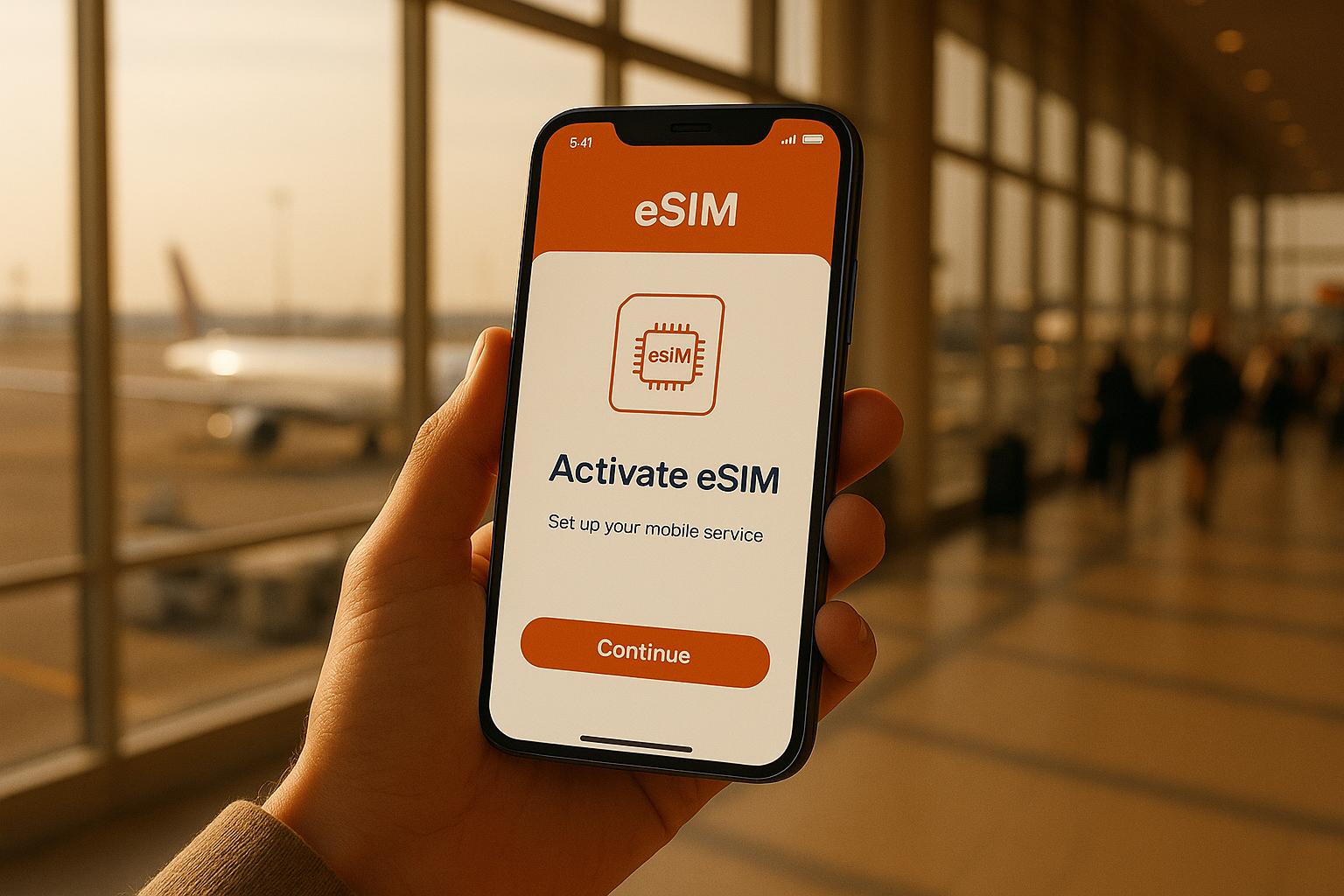eSIM vs Physical SIM: Which Is Better for Travel?
https://www.zimconnections.com/esim-vs-physical-sim-which-is-better-for-travel/
 SHARE
SHARE
When travelling, staying connected is crucial. You have two main options for mobile connectivity: eSIMs and physical SIM cards. Each has its pros and cons, but for most UK travellers, eSIMs are becoming the preferred choice. Why? They’re easier to set up, cheaper for avoiding roaming fees, and better for multi-country trips. Here’s a quick breakdown:
- eSIMs: Digital, built into your phone, activated remotely via QR code or app. Ideal for frequent travellers or those visiting multiple destinations. Plans start at ~£15/month, often cheaper than roaming.
- Physical SIMs: Removable cards, manually inserted into your device. Good for single-country trips or older phones. Costs vary but can include high roaming fees.
Quick Comparison:
| Feature | eSIM | Physical SIM |
|---|---|---|
| Setup | Digital, no physical card needed | Insert card manually |
| Cost | £15–40/month for global plans | £10–50 per country + roaming fees |
| Multi-country Use | No need to swap cards | Requires buying/swapping cards |
| Device Compatibility | Only for eSIM-enabled devices | Works with most phones |
| Eco Impact | No plastic waste | Generates plastic waste |
For frequent travellers, eSIMs save time, money, and hassle. Physical SIMs work best for older devices or single-country trips. Choose based on your travel needs and phone compatibility.
SIM Card VS eSIM: Which is best for Long Term Travelers? (Airalo)
What Are eSIM and Physical SIM Cards?
eSIM and physical SIM cards both serve the same purpose: connecting your device to mobile networks. However, they work in very different ways.
What is an eSIM?
An eSIM, short for embedded SIM, is a digital SIM card built directly into your device’s hardware. Unlike traditional SIM cards, it cannot be removed because it’s part of the device itself. Instead, it’s programmable through software.
“An eSIM is a digital version of the physical SIM card – identifying your device virtually to provide network connection. It’s programmable remotely via software and is built into newer smartphones, meaning you wouldn’t have to go purchase a new SIM card if you wanted to swap phones or wireless carriers.” – T‑Mobile
One of the biggest perks of eSIMs, especially for travellers, is the ability to activate them remotely. You can download and set up a data plan for a different country before you even leave home. They also offer added security since they can’t be physically stolen or damaged. Plus, eSIMs save space inside your device, which is a bonus for manufacturers.
Curious about how physical SIM cards differ? Let’s explore.
What is a Physical SIM?
A physical SIM is the removable chip that has been around for years. These come in various sizes – standard, micro, and nano – with nano being the most common today. Physical SIMs are tied to specific carriers, so if you want to switch networks, you’ll need to physically replace the card.
For travellers, this often means buying a local SIM card when you arrive at your destination or picking one up beforehand. While physical SIMs are widely supported by most carriers and devices, having to swap them can be a hassle. There’s also the risk of losing or damaging the card, which adds to the inconvenience.
Device Compatibility
When deciding between eSIM and physical SIM, it’s important to check if your device supports eSIM technology – especially if you travel frequently.
Many newer smartphones, including recent models from iPhone, Samsung Galaxy, and Google Pixel, are eSIM-compatible. To confirm, you can use #06# to check for an EID number, which indicates eSIM support. Alternatively, on iOS devices, go to Settings > Cellular > Add eSIM. On Android, navigate to Settings > Network & Internet > SIMs. If you see an “Add eSIM” option, your device is ready for this technology [14, 15].
Convenience and Ease of Use
When travelling abroad, eSIMs make activating and switching between networks a breeze.
How to Activate Each Option
Activating an eSIM is simple and can be done remotely. Typically, you purchase your eSIM plan online, receive a QR code via email, and then use your device settings to scan it. For instance, on iOS, you’d go to Settings > Cellular > Add Cellular Plan, while on Android, it’s Settings > Network & Internet > SIMs. This means you can set up your eSIM before you even leave home, ensuring you’re connected the moment you arrive at your destination.
In contrast, physical SIMs require a bit more effort. You’ll need to manually insert the SIM into your device’s tray, which usually triggers auto-activation. This often involves buying a local SIM at your destination – perhaps at an airport kiosk or a mobile shop – or bringing one with you in advance. While eSIMs can be set up in the comfort of your home, physical SIMs demand attention once you’ve arrived.
This difference in activation methods highlights the convenience eSIMs bring, especially when it comes to switching networks.
Switching Networks Abroad
For travellers exploring multiple countries, eSIMs offer unparalleled flexibility. Switching networks is as easy as selecting a stored profile on your device. Plus, you can store multiple eSIM profiles, allowing you to switch seamlessly as you cross borders. This is especially handy for travellers navigating through various regions.
On the other hand, physical SIMs require manual swapping, which not only takes more effort but also increases the risk of losing or misplacing the card.
If you have a dual SIM device, you can keep your UK number active on a physical SIM while using an eSIM for local data, helping to cut down on roaming charges. There’s also a security perk with eSIMs: if your phone is lost or stolen, your eSIM profile remains tied to your account rather than a physical card. This means you can quickly reactivate your service on a new device.
Adding to the convenience, nearly 400 mobile network operators now support eSIM technology globally as of 2023, making it easier than ever to access this feature wherever you travel.
Cost and Value for Travellers
Your choice of connectivity can have a noticeable impact on your travel budget, especially if you travel often.
eSIM Pricing
eSIM plans are a cost-effective alternative to traditional roaming fees. Many travel eSIM plans offer several gigabytes of data for around £15–40 per month, which is much cheaper than most roaming charges. For UK travellers, providers like ZIM Connections offer affordable eSIM plans with options for local, regional, and global coverage, allowing you to select the most suitable plan for your travel needs.
The price of eSIM plans varies based on your destination and data requirements. While costs differ between carriers, eSIMs consistently come out cheaper than roaming. Moreover, initial setup fees for eSIMs are usually low, and activation costs are often less than buying a separate physical SIM card.
Physical SIM Pricing
At first glance, physical SIM cards might seem like the cheaper option, as they’re often included for free with new mobile plans. However, the real costs become clear when you factor in roaming fees and the necessity of buying local SIMs while abroad. Traditional roaming charges can be steep, ranging from approximately £4–12 per day or £8–16 per MB of data. For UK travellers, the introduction of EU roaming fees post-Brexit has added to these costs. For example, Vodafone UK charges about £2 per day for EU roaming, with similar fees from EE and O2 on pay-as-you-go plans. Three UK, however, still offers free EU roaming on prepaid SIM cards.
If you’re considering tourist SIM cards in the UK, data-only plans typically range between £10 and £50 for durations of 5 to 30 days. While these may seem affordable, the costs can escalate quickly if you’re travelling to multiple countries and need to purchase a new SIM for each destination.
Cost Comparison
When comparing these options, the savings for frequent travellers become clear. For those travelling to a single destination on a short trip, physical SIM cards might be a reasonable choice if you can secure a good local deal. However, for frequent travellers or those visiting multiple countries, eSIMs often prove to be the better option overall. In fact, 78% of international travellers now prefer eSIMs, primarily because they save money on roaming fees and simplify connectivity management across countries.
The financial difference is even more striking when you compare roaming costs directly. Traditional roaming can cost £4–12 per day, whereas an eSIM plan costs about £15–40 per month. Over a two-week trip, roaming charges could easily exceed £80, while an eSIM plan might cost only £20–30. Additionally, eSIMs spare you the hassle and expense of buying new SIM cards in every destination.
For UK travellers exploring multiple European destinations, eSIMs are particularly advantageous. Regional plans provide seamless connectivity without the added expense of roaming fees, making them an excellent choice for those who want consistent savings and convenience on multi-country trips.
sbb-itb-273ea09
Global Coverage and Availability
Staying connected while travelling hinges on coverage and ease of access. Both eSIMs and physical SIM cards can provide global connectivity, but they operate differently when delivering that coverage.
eSIM Coverage Areas
eSIMs make global connectivity simpler. Leading providers now support over 200 destinations worldwide, making eSIMs a convenient choice for travellers visiting multiple countries. For instance, ZIM Connections offers coverage in more than 200 destinations with local, regional, and global plans, eliminating the hassle of buying separate SIMs for each country.
A standout feature of eSIMs is their ability to switch between networks for better reliability. This is especially useful when travelling through areas with inconsistent network quality. Many travel eSIM providers automatically connect users to the strongest available network, ensuring better signal strength and smoother roaming. For UK travellers, this means uninterrupted connectivity whether you’re navigating a busy city or venturing into remote countryside. The technology seamlessly handles network switching, even in regions with patchy coverage.
In comparison, physical SIM cards face different challenges when it comes to global availability.
Physical SIM Availability
Physical SIM cards are still widely used in regions such as Asia-Pacific, Africa, Latin America, and Eastern Europe. However, they can be harder to obtain when travelling abroad, especially in less accessible locations.
One of the main obstacles is availability. Finding physical SIM cards in remote areas can be tricky, and buying one often involves visiting a local store, overcoming language barriers, and figuring out unfamiliar mobile networks. Some countries even require ID registration to activate a SIM, adding extra complexity for international travellers.
That said, physical SIM cards do have their advantages in certain situations. If you’re staying in a single country for an extended period, they can provide more dependable connections by directly accessing domestic networks. Local carriers often deliver stronger signals and faster data speeds in rural areas, making them a practical option for travellers who won’t be moving between multiple destinations.
Network Reliability
When it comes to network reliability, both eSIMs and physical SIM cards rely on the same carrier networks, meaning their baseline performance is often identical when using the same provider. However, eSIMs have an edge thanks to their flexibility. They can automatically switch to a stronger network when coverage is weak, ensuring a more consistent connection across diverse terrains – an essential feature for international travellers.
On the other hand, physical SIM cards lack this adaptability. If your chosen carrier has poor coverage, you’re stuck with it until you physically replace the SIM.
It’s also worth noting that in countries with strict internet regulations, eSIM services may be restricted or entirely blocked. In such cases, a physical SIM card from a local provider might be your only reliable option for staying connected.
Impact on the Environment
As travellers become more environmentally aware, the choice between eSIMs and physical SIM cards is more than just a tech decision – it’s a chance to reduce your carbon footprint. eSIM technology stands out as a greener option, especially when it comes to cutting plastic waste and lowering emissions.
Reducing Plastic Waste
Physical SIM cards contribute significantly to plastic pollution. Every year, around 4.5 billion SIM cards are issued globally, resulting in over 18,000 tonnes of plastic waste – most of it from non-biodegradable polyvinyl chloride (PVC). These cards also require additional plastic for packaging, all of which ends up in landfills.
eSIMs, on the other hand, completely eliminate the need for physical cards. They use less than 1% of the materials needed to produce traditional SIMs, making them a far cleaner choice. For UK travellers visiting multiple countries, the impact is even more noticeable. Instead of accumulating a pile of plastic SIM cards, a single eSIM provides seamless connectivity across borders without generating any waste.
Lower Carbon Footprint
The environmental toll of traditional SIM cards goes beyond just plastic. The industry is responsible for approximately 180,000 tonnes of CO₂ emissions annually, with carbon output coming from manufacturing, packaging, and global distribution.
eSIMs significantly reduce this impact. They generate 46% fewer CO₂ emissions compared to physical SIM cards. Over its lifecycle, an eSIM produces 123g of CO₂ equivalent, while a traditional SIM card generates 229g of CO₂ equivalent over a typical three-year phone lifespan. By switching to eSIMs, the industry could potentially save 4.4 million tonnes of CO₂ equivalent by 2025.
One key factor is digital activation. With eSIMs, there’s no need for trucks to deliver SIM cards to stores or planes to ship them across countries. This eliminates the emissions tied to the entire physical supply chain. When you activate an eSIM, like those from ZIM Connections, you’re connecting to the world without adding to unnecessary carbon output.
“Traditional SIM cards are quietly harming the planet through plastic waste and emissions. eSIMs cut the clutter – no plastic, no shipping, just greener tech.”
Here’s a quick comparison of the environmental impact of eSIMs versus physical SIM cards:
| Environmental Factor | eSIM | Physical SIM |
|---|---|---|
| Plastic Use | None | High (card and packaging) |
| Energy Consumption | Up to 80% less | High |
| Waste Generation | Minimal (no physical waste) | High (discarded cards and packaging) |
| Material Usage | Less than 1% of physical SIMs | Significant (plastic and metal) |
| CO₂ Emissions | 123g CO₂ equivalent | 229g CO₂ equivalent |
For UK travellers aiming to minimise their environmental impact, eSIMs offer a straightforward way to travel more sustainably. Not only do they provide excellent connectivity, but they also align with the growing need for eco-friendly choices.
eSIM vs Physical SIM: Side-by-Side Comparison
When it comes to travel, the differences between eSIMs and physical SIMs are best understood when compared directly. Here’s a breakdown of how these two options stack up for UK travellers:
Comparison Table Features
| Feature | eSIM | Physical SIM |
|---|---|---|
| Activation Process | Digital activation via QR code or app | Requires manually inserting the SIM card into the device |
| Cost for Travel | £15–50 for 1–10GB regional plans | £10–50 per country, plus SIM card costs |
| Device Compatibility | Works only with eSIM-enabled devices | Compatible with nearly all devices |
| Convenience | Allows instant switching between carriers and plans | Requires swapping physical SIM cards |
| Setup Complexity | Slightly more involved, involving QR codes or apps | Straightforward – just insert the SIM card |
| Multi-Country Use | No need for new SIMs when changing countries | Requires a new SIM for each country |
| Risk of Loss/Damage | Embedded in the device, so minimal risk | Physical cards can be lost or damaged |
| Environmental Impact | Uses less than 1% of the materials compared to physical SIMs | Generates about 18,000 tonnes of plastic waste annually |
| Network Switching | Enables digital switching to local carriers | Requires purchasing or swapping local SIMs |
| Storage Capacity | Can store multiple profiles on one device | Limited to one profile per SIM card |
| Roaming Charges | Local data plans help avoid roaming fees | Roaming charges may apply |
| Purchase Convenience | Instant digital purchase and activation | Requires visiting physical stores abroad |
This comparison highlights the strengths of each option. For frequent travellers, particularly those navigating multiple destinations, eSIMs offer unmatched convenience. Plans can be activated digitally before even leaving the UK, eliminating the hassle of hunting for local SIM cards upon arrival.
That said, physical SIMs still hold their ground in certain areas. They are universally compatible with most devices and have a simple setup process, making them a practical choice for older devices or users who prefer traditional methods.
When it comes to cost, the choice depends on your travel plans. eSIMs often save money by avoiding roaming fees, while physical SIMs may be more economical for single-country trips. For those concerned about sustainability, eSIMs provide a clear advantage, potentially cutting down on millions of kilograms of plastic waste annually.
Both options have their place, but for modern travel needs, eSIMs stand out with their ease of use, eco-friendly design, and flexibility.
Which Option Is Better for UK Travellers?
Choosing the right SIM option depends on your travel habits, device compatibility, and what matters most to you while abroad. For many UK travellers, eSIMs stand out as a top choice for staying connected internationally.
eSIMs are especially handy for frequent travellers hopping between multiple countries. They offer the convenience of avoiding roaming charges and provide instant connectivity across borders – something experts often praise for its flexibility.
The potential savings with eSIMs are also worth noting. For example, Martin Lewis demonstrated this when he used a one-month 10GB eSIM plan for just £18, which worked out far cheaper than traditional roaming fees. For short trips where you only need data, eSIMs are both convenient and economical.
That said, physical SIMs still have their place, particularly for those using older phones or budget devices that don’t support eSIM technology. They’re compatible with nearly all mobile devices, and the setup couldn’t be simpler – just insert the card. This traditional approach can be appealing for travellers who prefer a straightforward solution. However, it’s crucial to check your device’s compatibility before making a decision.
If you’re considering eSIMs, ensure your phone supports the technology. Many modern smartphones do, including Apple models from the iPhone XS onwards, Google Pixel devices starting with the Pixel 3, and Samsung’s Galaxy S20 series and newer. Additionally, many flagship devices support dual SIMs for even more flexibility.
For those ready to make the switch, providers like ZIM Connections offer eSIM plans for over 200 destinations. These plans include 5G/4G connectivity and unlimited data, all without the headache of roaming charges.
FAQs
How can I check if my smartphone supports eSIM before travelling?
To check if your smartphone supports eSIM, head to Settings > Connections > SIM Manager and see if there’s an option for ‘Add eSIM’. Another quick way is to dial #06# – if your device shows an EID number, it’s eSIM-compatible.
Still unsure? Look under the ‘About Phone’ section in your settings for an EID, or visit the manufacturer’s support page to find a list of supported models. Confirming eSIM compatibility before travelling can save you time and make setting up abroad much easier.
How does using an eSIM help reduce environmental impact when travelling?
Choosing an eSIM for your travels can make a meaningful difference to the environment. Since eSIMs don’t require a physical card, they eliminate plastic waste and reduce the energy involved in manufacturing and distributing traditional SIM cards.
This simple switch not only promotes greener travel but also helps lower the carbon emissions tied to shipping physical SIM cards across the globe.
Are there any restrictions or challenges when using eSIMs in countries with strict internet regulations?
Some countries with stringent internet regulations might place restrictions on eSIM usage. These limitations can interfere with activation or restrict roaming services, which could make staying connected while travelling more challenging.
To avoid surprises, it’s a good idea to check the rules and regulations of your destination in advance. If eSIM services are limited or unavailable in certain areas, you may need to consider other connectivity options to ensure you can stay online.









































































































































































































